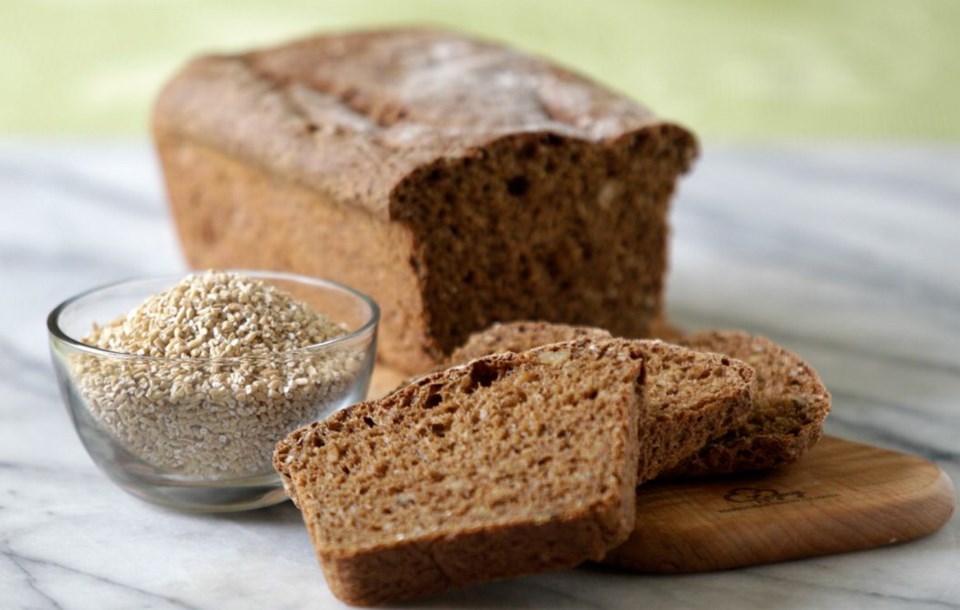Dear Eric: Could you give me some information about Scottish oatmeal? How is it different from “regular” oatmeal, and can you use it instead of oats in recipes or do you have to treat it differently?
Lucie
Dear Lucie: After harvesting, oat grains are cleaned, toasted and hulled — removal of the inedible husk but not the bran. The resulting product is oat groats.
The way the groats are processed affects how they are named, the cooking time to make a bowl of oatmeal and how suitable that particular type of oat is for a baking or other cooking.
For Scottish oats — also known as steel-cut, pinhead and Irish oats — the groats are cut with steel blades into about three pieces. This was once the most common type of processing of oats.
Oatmeal made with steel-cut oats require a longer cooking time than other forms of oats. For example, on the back of a package of Bob’s Red Mill brand steel-cut oats, the method for making hot cereal involves simmering the oatmeal 10 to 20 minutes, depending on how chewy you like it to be.
Don’t use steel-cut oats in recipes that call for rolled oats or quick-cooking oats. Steel-cut oats used in cookie dough, for example, would still be hard and unappealing at the end of the baking time.
You can bake with steel-cut oats, but use recipes that tell you to pre-cook or soak the oats to soften them, as in my bread recipe today.
What Lucie calls “regular” oats first appeared in 1877 when the Quaker Oat Company developed a process to roll and flatten the oat groats, making them thinner and quicker to cook. Flaked oats come in three main forms.
Large-flake rolled oats are made by steaming then rolling oat groats to produce flat flakes. Porridge made with this type of oat requires about five minutes of cooking.
Because of this quick cooking time, and because the large flakes add a nice texture and rich oat flavour, large-flake oats are excellent for use in cookies, crumbles and loaves, as well as granola and meatloaf.
Steaming, rolling and cutting oat groats into several pieces results in quick-cooking rolled oats that, as the name suggests, cook even more quickly than large-flake rolled oats.
Quick-cooking rolled oats can be used in many recipes, but they tend to vanish in baked goods and they lack the rich oat flavour or the large flakes.
Instant oatmeal is made by rolling the groats very thinly and cutting them into even smaller pieces. Pour boiling water over a bowl of these oats and you have instant breakfast. Instant oatmeal is not recommended for baking because much of the oat texture and flavour is lost during processing and the added salt and preservatives will mar your baking.
Steel-Cut Oat Bread with Walnuts and Molasses
This very hearty, dense bread has a lovely, chewy oat texture. It tastes particularly good topped with marmalade and slices of sharp cheddar cheese. It will also go well with your morning eggs or with a bowl of soup for lunch.
Preparation time: 20 minutes, plus soaking, kneading and rising time
Cooking time: 45 to 50 minutes
Makes: 2 loaves
1 cup steel-cut oats
1/4 cup cooking molasses
1 tsp sea or kosher salt
1 Tbsp soft butter or 1 Tbsp vegetable oil, plus some for the bowl
2 cups boiling water
1/4 cup lukewarm water
1 packet (2 1/4 tsp) active dry yeast
2 1/2 cups all-purpose flour, plus some for shaping
2 cups whole wheat flour
3/4 cup chopped walnuts
• vegetable oil spray for greasing
Place the oats, molasses, salt and 1 Tbsp butter or oil in a medium heatproof bowl. Pour in the 2 cups boiling water and stir to dissolve the molasses into the water. Let stand 1 hour, or until the liquid is tepid.
Combine the 1/4 cup of lukewarm water and yeast in the bowl of your stand mixer. Let stand until the yeast is dissolved, about five minutes. Add the all-purpose and whole-wheat flours, walnuts and the soaked oats and their liquid.
Use a dough hook to mix and knead the dough 8 to 10 minutes. (The dough will be a little wet, as the oats will continue to absorb moisture while the dough rises.)
Lightly butter or oil a large bowl. With lightly floured hands, transfer the dough to the bowl. Cover the bowl with a damp kitchen towel and let the dough rise in a draft-free place at warm room temperature until 1 1/2 to twice its original size, about 90 minutes.
Grease two 8 1/2 inch by 4 1/2 inch non-stick loaf pans with vegetable-oil spray.
Turn risen dough onto a lightly floured work surface (no need to punch it down) and divide into two equal pieces. Shape each piece into oblongs the same length as the pan. Set one oblong into each pan. Cover the pans with the kitchen towel and let rise until the bread is 1 1/2 to two times its original size, about 90 minutes.
Preheat the oven to 350 F. Bake the bread 45 to 50 minutes. (When it’s done, the crust will be dark golden brown and the bottom of the loaf will sound hollow when tapped.) Set baking pans on a cooling rack and cool 15 minutes. Remove the loaves from the pans and cool.
Note: The steel-cut oats used in this recipe were Bob’s Red Mill brand.
Eric Akis is the author of the just-published hardcover book Everyone Can Cook Everything. His columns appear in the Life section Wednesday and Sunday.
The Sunday column topics are chosen by readers. You can send cooking questions to Eric by email or write: Ask Eric, Times Colonist, 2621 Douglas St., Victoria B.C., V8T 4M2.



